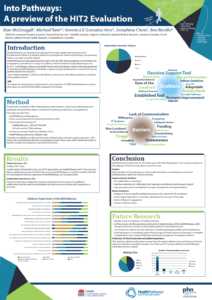 This poster was presented by Mr Ben Neville on behalf of the HIT2 evaluation team, at the 1st Asia Pacific Conference on Integrated Care, Brisbane Australia, 6-8 November 2017. (PDF)
This poster was presented by Mr Ben Neville on behalf of the HIT2 evaluation team, at the 1st Asia Pacific Conference on Integrated Care, Brisbane Australia, 6-8 November 2017. (PDF)
McDougall A, Tam M, Gonzalez-Arce VE, Chow J, Neville B. Into Pathways (A Preview of the HIT2 Evaluation). International Journal of Integrated Care 2017; 18(S1): A115, pp. 1-8, DOI: dx.doi.org/10.5334/ijic.s1115
Abstract
Introduction:
HealthPathways is an integrated care approach that brings together general practice and hospital-based clinicians to develop agreed local management streams and pathways, and document these on an easily accessible website. It provides general practice teams with clinically relevant guidance on the assessment, management, and referral of a range of conditions, which are linked to locally relevant resources.
In July 2015, HealthPathways was implemented by a Local Health District (LHD) and a Primary Health Network (PHN). Type 2 Diabetes (T2DM) was identified as a priority area.
Methods:
This is a programmatic evaluation on the development, implementation and acceptance of T2DM pathways, with qualitative and quantitative data being collected and analysed from a range of sources to better understand the pathways implications and applications.
This study uses data from:
- HealthPathways working groups
- Online survey responses from General Practitioners (GPs)
- Semi-structured interviews of:
- Stakeholders (e.g., LHD and PHN staff)
- GPs who use the T2DM pathways
- Anonymous surveys of patients at diabetes clinics
- HealthPathways web server utilisation data
Interviews are digitally recorded and transcripts analysed using a thematic analysis approach – with initial codes generated directly from the participant’s words. These codes will be abstracted further to identify concepts and categories to generate final themes.
Results:
NOTE: This project is currently recruiting participants and undergoing analysis.
Current results indicate that 68% of GP respondents use HealthPathways, with 39% on a daily to weekly basis and nearly half (47%) use HealthPathways in caring for a patient with DM.
Thematic analysis from stakeholder interviews emphasise the importance of established collaborations and the need for standardized tools with common priorities and transparency in processes.
Discussion:
This preliminary analysis suggest that those who use HealthPathways have found it to be a practical tool that supports their diagnostics process and provides information of high quality. However, it also highlights that there is a lack of awareness of the HealthPathways within general practices.
Conclusions:
- HealthPathways has been live for 18 months and is still under development
- Due to early evaluation of the pathways, clinical outcomes data is not in the scope
Lessons:
- Early evaluation of the pathways can only provide information on development and project implementation, rather than clinical outcomes
Implementation Enablers:
- Key stakeholders’ commitment
- Seamless networks and collaboration with steering committee and working party rapport
- Clear processes and accountabilities for project management and implementation
Study Limitations:
- Analysis of only one specific pathway has proven to be a barrier for GP recruitment
- Project design dependent on volunteer participation for two arms of the study
- Extent of dynamic engagement
- Access to Diabetes Clinics
Suggestions for Future:
- Broader scope for evaluation of multiple pathways
- Further enquiry into the experiences and practical implementation of the HealthPathways within the general practice business model (including referral to specialised services)
- Evaluation of clinical outcomes and patient experience
- Cost analysis for impacts on lower duplication of pathology/imaging studies and hospitalisations
- Potential impact on streamlining patient flow through the health system and decrease on avoidable hospitalisations due to early identification and timely management of targeted conditions
